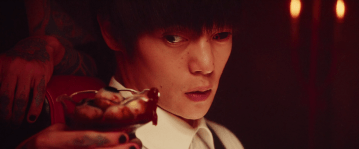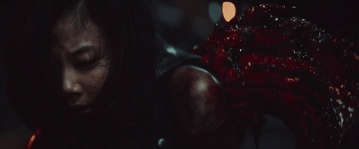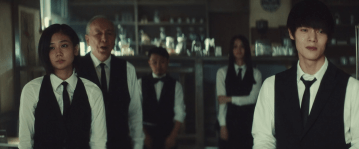Introduction
It has become a normal sequence nowadays in Japan: A good selling manga becomes an anime-series and, if there is enough financial potential, made into a live-action movie. (General-note 1). Tokyo Ghoul, the Japanese dark fantasy manga series drawn and written by Sui Ishida, has followed this sequence and was ultimately made into a live-action adaptation, giving an opportunity for Kentaro Hagiwara, as this is his first feature, to prove his worth as a director.
To celebrate Shueisha’s January reveal that Tokyo Ghoul and its sequel series Tokyo Ghoul:re attained a combined 34 million copies in print worldwide, we present our review of Hagiwara’s cinematographical rendition of the first three tankobons. Is is better than most live-action adaptations that were released in recent years or not?
Review
In Tokyo, ghouls, are living among humans. As they hunt humans for food, they form a lurking threat to human life. To safeguard human beings, the government-formed Commission of Counter Ghoul (CCG) hunts the ghouls and try to exterminate as many as possible. Alas, they continue to exist in the shadows of the vast city.
One day, Ken Kaneki (Masataka Kubota), a normal university student, finds the courage to ask Rize Kamishiro (Yu Aoi), the girl he is in love with, on a date. To his surprise, she accepts. When things starts getting romantic, Rize suddenly bites Kaneki, revealing herself as a ghoul. Luckily, Kaneki survives this encounter by undergoing surgery, but is forced to accept the fact that he has become a half-ghoul (general-note 2).

The best way to describe the narrative of Tokyo Ghoul is to consider it as a coming-of-age narrative, or more correctly put, a coming-into-being narrative. After becoming a half-ghoul, Kaneki’s first trail concerns accepting his new reality as half-ghoul, like the fact that human flesh has become his diet. As is implied in the narrative, this path of acceptation is synonym for realizing a subjective position as a half-ghoul as such. Luckily, as is common with these kind of stories, he is accepted within a small symbolic network, i.e. the neighborhood cafe Anteiku, and finds a mentor in Yoshimura (Kunio Murai), the cafe’s manager, as well as a trainer in his co-worker, Touka (Fumika Shimizu). Both characters help him gain an orientation within this new society.
While the manga, by way of including internal dialogue, is able to explore Kaneki’s internal struggle with his transformation more deeply, the choice to omit this internal dialogue and, instead, express it non-verbally, succeeds in evoking his struggle in a sensible way. This omission also allows Hagiwara to retain a decent narrative pace and explore various relationships within this small symbolic network. Furthermore, by allowing us a look at the inner-workings of the CCG, a morally ambiguous contrast between both parts of society is evoked – there is no clear-cut difference between good or bad. But while the aforementioned elements could have allowed the narrative to become outstanding, Hagiwara superficial treatment of Kaneki’s coming-to-terms with his ghoul-nature castrates the narrative from the moving moment is desperately needed. In other words, by failing to give Kaneki’s pivotal change its moving dimension, the coming-into-being narative lacks the catharsis to function properly.

At the level of the cinematography, Kentarō Hagiwara does impress. His visualization of Tokyo Ghoul is exciting and visually engaging (cine-note 1). While the cinematography mixes fixed and moving shots like any other narrative, Kentarō Hagiwara’s blend is highly effective in evoking an array of emotions and framing the horror-action in an exciting and, often slightly, disturbing way. His subtle shifts from (often subjective) shaky shots, as a cinematographical way to express Kaneki’s emotions, to steady shots that often fixate on facial expressions, are successful in establishing a path of identification (between the spectator and Kaneki) and enforcing, when necessary, the tension in the narrative (Cine-note 2, Cine-note 3).
Eventually Hagiwara diminishes his use of shaky shots, but his compositions of action-scenes remain as exciting as before. The tension present in these scenes is supported by Hagiwara’s successful toying with cinematographical distance and by an attentive and rather subtle interweaving of looming sounds and suspenseful music into the imagery. This mix of sounds and music is, furthermore, instrumental in evoking Kaneki’s mental state and underlining his rather abrupt coming-to-terms with his condition (Narra-note 1). Nevertheless, this acoustic underlining does not allow his coming-to-terms its much needed cathartic power.

Tokyo Ghoul is, when all is said and done, a very visually appealing narrative. Besides succeeding in evoking a vast array of emotions, evocations benefiting from the fitting acting performances, Hagiwara also succeeds in framing the horror-action, which relies on CGI, in an exciting way. But despite the visual appeal of the narrative, one major narrative flaw, the failure to turn Kaneki’s coming-to-terms into a moving experience, curtails the power the narrative should have had. Notwithstanding this flaw, Tokyo Ghoul still remains one of the better high-budget live-action adaptations to appear in recent years. It even serves as a perfect introduction for newcomers to Ishida’s world of ghouls.

Notes
General-note 1: Of course, there are exceptions to this rule.
General-note 2: As the movie does not always explain the ghoul-terminology, we do want to give two short definitions. ‘Kagune’ is a special predatory organ that can manifest itself and be used as a weapon during battle. ‘Kakugan’ refers to the color of eyes. when Ghouls are excited or hungry the sclera in their eyes turn black and their irises red.
Cine-Note 1: To create a visually engaging narrative, Hagiwara uses a diverse palette of techniques, e.g. extreme close-ups. close-ups, pov shots, slow zoom-ins and zoom-outs. The use of zoom-in and zoom-outs prove once again that, if they are used thoughtfully, they are an added value to the cinematography.
Cine-note 1: When shaky shots are used, they always aim to express Kaneki’s subjective position.
Cine-note 3: Besides cinematographical fixating on expressions and setting the stage for moments of surprise, fixed shots and concatenations of those shots – as moments of pause – are often used to frame those moments where characters are “fixed” themselves, e.g. when Kaneki and Rize having their restaurant date. Nevertheless, exceptions are present.
Narra-note 1: Despite Kaneki’s coming-to-terms with his condition, one important subjective fear remains. As made apparent in the end, Kaneki remains afraid to lose control over his humanity and succumb, albeit temporarily, to his ghoul-nature. At a deeper level, one could argue that, even though he comes to terms with certain aspects of his ghoul-nature, a moral problem between his human side and ghoul side does persist.
2 Comments Add yours